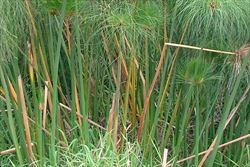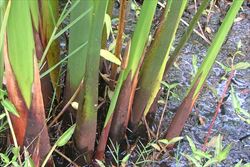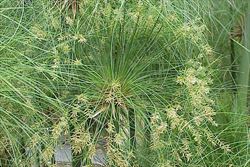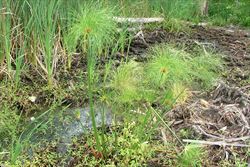Click on images to enlarge

infestation (Photo: Sheldon Navie)

habit (Photo: Sheldon Navie)

habit (Photo: Sheldon Navie)

robust three-sided flowering stems (Photo: Sheldon Navie)

base of stems showing leaves that are reduced to brownish-coloured sheaths (Photo: Sheldon Navie)

young seed-head with numerous fine branches (Photo: Sheldon Navie)

close-up of seed-head branches showing clusters of elongated flower spikelets (Photo: Sheldon Navie)

young plant (Photo: Sheldon Navie)
Scientific Name
Cyperus papyrus L.
Family
Cyperaceae
Common Names
bull rushes, bulrush, Egyptian paper plant, Egyptian papyrus, Egyptian papyrus plant, Nile grass, paper plant, paper reed, papyrus, papyrus plant, papyrus sedge
Origin
Native to Africa (i.e. Ethiopia, Sudan, Kenya, Tanzania, Uganda, Cameroon, Zaire, Benin, Nigeria, Senegal, Malawi, Mozambique, Zimbabwe, Botswana, Namibia, South Africa and Madagascar).
Naturalised Distribution
Naturalised in south-eastern and central Queensland, in the coastal districts of northern and central New South Wales, and near Perth in south-western Western Australia.
Also naturalised overseas in southern USA (i.e. California, Louisiana and Florida) and Hawaii.
Notes
This species is regarded as a minor environmental weed or potential environmental weed in Queensland and New South Wales. It has escaped cultivation and invaded the margins of permanent water bodies in south-eastern Queensland and northern New South Wales. For example, infestations were recently targeted for removal from Seaham Swamp Nature Reserve at Port Stephens on the mid-north coast of New South Wales.
Papyrus (Cyperus papyrus) is also a weed of deep water channels in the Warriewood Wetlands and a common weed in the Lakes of Cherrybrook Reserve in suburban northern Sydney. In south-western Western Australia it grows in permanently wet sites and in abandoned parklands. This rapidly growing species can spread to cover areas of open water, preventing other aquatic species from growing, and reducing light levels to submerged native plants.

